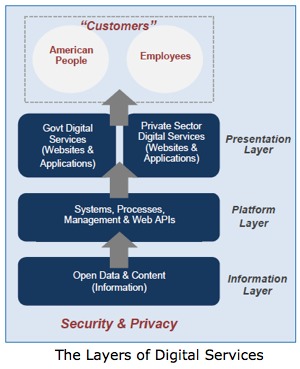Hang Together or Hang Separately? U.S. Digital and Information Sharing and Safeguarding Strategies
Last year, the U.S. Government published both a “Digital Government Strategy” (PDF) as well as a “National Strategy for Information Sharing and Safeguarding” (PDF). Each has its own community of champions, but common and mutually supporting themes will require active collaboration and partnership across communities for both strategies to be successful in the long term.
 When the digital strategy was published, the overwhelming attention was focused on near term aspects such as mobility and web APIs. That focus in some ways obscures the truly transformational aspect of the strategy, which is the introduction of a conceptual model for digital services that makes information a first class citizen.
When the digital strategy was published, the overwhelming attention was focused on near term aspects such as mobility and web APIs. That focus in some ways obscures the truly transformational aspect of the strategy, which is the introduction of a conceptual model for digital services that makes information a first class citizen.
The model acknowledges three layers of digital services; the information layer, platform layer and the presentation layer.
The information layer contains both structured information as well as unstructured information.
The platform layer includes the systems and process that manage and add value to this information.
The presentation layer defines the multiples channels by which this information can be organized, presented and delivered to customers.
The model also acknowledges that customers include both employees as well as the american people.
And last, but not least, the entire service delivery mechanism needs to have the appropriate security and privacy safeguards built in at all layers.
When looking at overarching strategies, it is important to keep in mind the real world in which the strategies need to execute. In IBM’s Fast Track to the Future: The 2012 IBM Tech Trends Report (PDF), IBM identifies the four trends that are shaping our daily lives:
- Business Analytics
- Cloud
- Mobile
- Social
The change in mind-set as articulated by the digital strategy conceptual model is directly applicable to how government successfully navigates and leverages these trends.
At the same time, the IBM report also notes:
Security concerns consistently rank as the most significant barrier to adoption across mobile, cloud computing and social business. Even in business analytics, where data typically stays inside an organization’s firewall, securing and controlling access to data still places as the number-two barrier to adoption.
The core message is clear: IT security is not just a technology concern; it’s a broad business issue with far-reaching policy and process implications. Moving into mobile means organizations must address the increased risk of data loss and security breach, device management challenges, and complications introduced by the growing trend toward bring-your-own-device. Analytics adoption forces decisions on data privacy, retention and access control for both the raw data and derived insights. Cloud computing calls for policies on employee use of public cloud services (e.g., file-sharing services), segregation of data within shared or hybrid cloud solutions and ensuring the right data is in the right place subject to the right controls. And with social business, organizations need to consider customer privacy expectations, regulatory compliance, and employee guidelines on confidentiality, acceptable use and protecting the corporate brand.
In each area, organizations are struggling to protect what is arguably their most important asset: information
The ability to make relevant information available at the point of action while applying the appropriate privacy and security safeguards is where, I believe, the Information Sharing and Safeguarding Strategy and the Digital Government Strategy have shared goals:
| Digital Government Strategy | Information Sharing and Safeguarding Strategy |
|---|---|
|
|
Given the mutually supporting aspects of the two strategies, long term success for both will require collaboration and partnership across multiple communities which often have had differing perspectives on information sharing and protection.
RELATED INFO
- Digital Government: Building a 21st Century Platform to Better Serve the American People (PDF)
- National Strategy for Information Sharing and Safeguarding (PDF)
- IBM’s Fast Track to the Future: The 2012 IBM Tech Trends Report (PDF)
This blog post first appeared on Anil John | Blog (https://blog.aniljohn.com). The opinions expressed here are my own and do not represent my employer’s view in any way.




